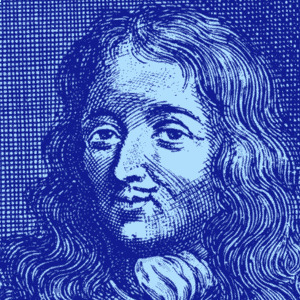Charles de Batz de Castelmore, better known as D’Artagnan, lived during the seventeenth century. This lieutenant-captain of the King’s Musketeers and son of Gascony died in battle in 1673 at around age sixty. He knew Mazarin, Anne of Austria and Louis XIV, all of whom he served with loyalty and courage.
In the year 1700, some thirty years after his death, a publicist by the name of Gatien Cortilz de Sandras “rediscovered” D’Artagnan.
He wrote an apocryphal autobiography of the latter entitled The Memoirs of Monsieur D’Artagnan, in which the real and the fictional hero intertwined. Almost one hundred fifty years later, a brilliant novelist by the name of Alexander Dumas happened upon this work of quasi-fiction and, with the help of his acolyte Auguste Maquet, proceeded to transform these “memoirs” into a novel. Since The Three Musketeers first rolled off the printing press in 1844, D’Artagnan has become a beloved hero to millions of readers the world over… or, at least, a certain d’Artagnan, fictional hero of sword and cape adventure novels.
At the end of the nineteenth century, Jean de Jaurgain, corresponding member of the Royal Academy of Madrid, conducted biographical research on the “real” musketeers referred to in Dumas’ novel. He was able to partially retrace the history of the real d’Artagnan.
However, it took until 1912 for D’Artagnan to find his first real biographer in the person of Charles Samaran. This native of Gascony, director of the Archives of France, embarked on a thorough research project which has allowed us to retrace the real life of this captain of the musketeers, a life that had theretofore been overshadowed by the myth. A number of authors, historians, researchers, academicians and journalists would follow in Samaran’s footsteps. Their research and writing has, little by little, breathed Charles de Batz de Castelmore back into life –his real life, that is.
Armand Praviel, André Laffargue, Jean-Christian Petitfils, Odile Bordas, Stéphane Beaumont and others have continued to search archives, compare testimonies and rely on history in order to perfect the portrait of this rather uncommon man.
The history of d’Artagnan presented here pays homage to these men and women. It is not our intention that this history be yet another version of the life of d’Artagnan. In light of the research that has already been done, such an undertaking would be nothing more than plagiarism. Rather, it is our intention to present a synthesis of the research presented by these and other authors, with an eye to helping new readers discover these works.
The real d’Artagnan, who reveals himself here to internet users, owes everything to the above authors who have managed to rehabilitate him. This challenge was all the more difficult in that Dumas’s d’Artagnan has seduced so many audiences from film to comic books and even cartoons. But, so brilliant was the genuine character and so talented his biographers that, nearly four centuries after his birth in the little Gascon village of Lupiac, d’Artagnan still has a thing or two to teach us.
1883-84 et 1910 - Jean de Jaurgain
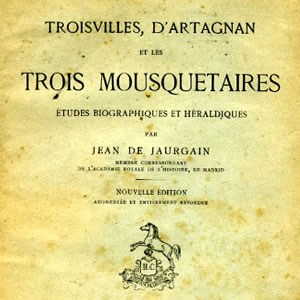
Troisvilles, D’Artagnan and the Three Musketeers: Biographical and Heraldic Research
Honoré Champion, editor, 1883-1884 and 1910.
Jean de Jaurgain was an historian from Béarn and a corresponding member of the Royal Academy of History of Madrid.
An extract from the prologue: “One can judge from the following pages, which are not without interest for the general history of the French nobility, how unfounded is the wide-spread opinion in many modern manuals that, under the ancien regime, the most important military and civil commissions were the exclusive privilege of a closed caste, and that the ennobled formed an inferior category, despised by the sovereign and gentlemen from ancient lineages. Nothing could be further from the truth (…) Families that became important members of the French aristocracy, such as the Peyré-Troisvilles, the Batz-Castelmore d’Artagnan, the Sillègue-Athos, the Portau, the Baas and the Boeil, all had modest origins!”
1912 (reedited 1967) - Charles Samaran
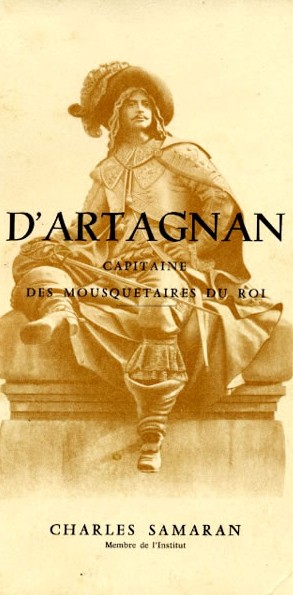 « D’Artagnan »
« D’Artagnan »
Editions Calmann-Lévy, 1912
(reedited by Bouquet, Auch, 1967)
Charles Samaran was born in Cravencères, near the town of Nogaro in the Gers (part of historic Gascony), in 1879. After graduating from the Ecole des chartes, he continued his training at the School of Rome and in the French National Archives in 1904, of which he later became the director as well as a member of the Institute.
A passage from the first chapter of D’Artagnan: “Charles de Batz de Castelmore, known as d’Artagnan –these are the only names and titles our hero had the honor of carrying into history—never had the chance to enjoy this universal fame, neither during his lifetime nor long after his death. He was most certainly a real gentleman, an experienced soldier, an adroit diplomat when the occasion demanded it, and, in all circumstances, a suave and nimble Gascon without being obsequious. (…) Upon his valiant death, each and every person exalted the conscience, zeal, bravery and generosity of this perfectly gallant man. But his glory ends there, because –it must be said—d’Artagnan owed his immense posthumous fame to hazard.”
1933 - Armand Praviel
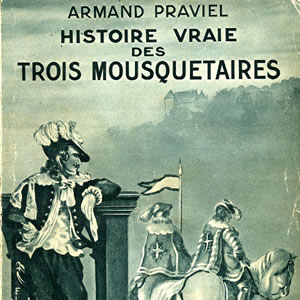 The Real History of the Three Musketeers, Flammarion Editions (collection Hier et aujourd’hui), 1933.
The Real History of the Three Musketeers, Flammarion Editions (collection Hier et aujourd’hui), 1933.
Armand Praviel was born in 1875 in Isle Jourdain, in the Gers. This rather colorful individual was 24 years old when he donned a black cape lined with red velvet, which he would wear for the rest of his life, even to the point of having himself buried in it! After having been a prisoner during the First World War, he wrote his first novel, which was an immediate success. During his life, he wore the hats of poet, journalist, literary critic, theater actor and novelist.
Extract: “As Mr. Charles Samaran once said (…) d’Artagnan is the ultimate Gascon, or better, the ultimate Frenchman (…) Let us add with a little less indulgence: [he] was the conventional model that inspired our literature of the nineteenth century and that made our grandmothers dream, the model of the French chevalier, the young colonel of Monsieur Scribe: foolhardy, vain, spendthrift, fickle, rebellious and generous, goateed and mustachioed. His caricature still lives on today. That’s the very model of a musketeer perpetuated by his immortality. It is for our readers to decide whether they prefer the real man to the legend.”
1979 - André Laffargue
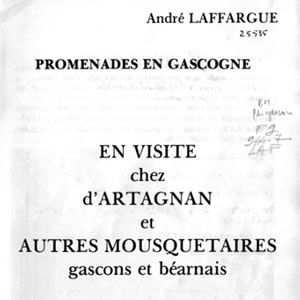 A Visit with D’Artagnan and Other Musketeers of Gascony and Béarn
A Visit with D’Artagnan and Other Musketeers of Gascony and Béarn
CTR Marsolan Editions, Promenades en Gascogne, 1979.
A native of Gascony and graduate of the military academy of Saint Cyr, André Laffargue distinguished himself during the First World War by beating back an enemy attack. Promoted to the rank of colonel in 1939 and general in 1942, he then joined the Resistance. He became the adjutant to General de Lattre de Tassigny in 1944. Historian emeritus, his wish was to shed light on his native region through the illustrious personalities that populated his work.”
An extract from the introduction:
“D’Artagnan, which Courtilz de Sandras, unsure of his hero’s origins, made a Béarnese man, was in fact a Gascon. (…) On the other hand, Troiville (or Tréville), captain of the Musketeers, and the Three Musketeers, Athos, Portos and Aramis, were from Béarn. Is it necessary to add that the Gascons and the Béarnese are brothers –speaking the same language, living under the same sky and among similar hills? Indeed, didn’t Henry IV, though born in Pau [in Béarn] call himself a Gascon?”
1981 - Jean-Christian Petitfils
 The Real D’Artagnan,
The Real D’Artagnan,
Tallandier Editions, 1981.
Born in 1944, Jean-Christian Petitfils is a graduate of the French Institute of Political Studies; he has a doctorate in Political Science and a law degree. Besides his emphasis on political science, he is also a respected expert on classical France and author of some fifteen book, including works on the history of political ideas and the history of the seventeenth and eighteenth centuries.
An extract from the cover of The Real D’Artagnan: “D’Artagnan’s posthumous fate (born around 1613 and died in 1673) is one of the strangest ever. Completely disfigured –but with what genius!—by Dumas and even more –but with considerably less talent—by Courtilz de Sandras, that famous autobiographical forger from the end of the seventeenth century, this cadet of Gascony (1) “who came up to Paris” (2) is unknown to the point that one could wonder whether he really existed at all (…) Yes, d’Artagnan existed! His heroic and adventurous life is neither that recounted in his so-called memoirs (in reality due to Courtilz de Sandras) nor that of Dumas, but it merits well these versions! [His life] remains to be discovered. Jean-Christian Petitfils will not disappoint his readers!”
1995 et 2001 - Odile Bordaz
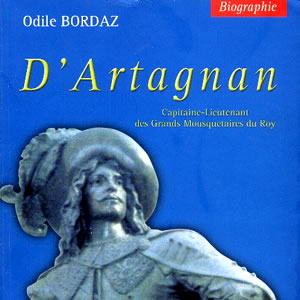 D’Artagnan, the King’s Musketeer: His life, his times, his contemporaries, Griot Editions, 1995.
D’Artagnan, the King’s Musketeer: His life, his times, his contemporaries, Griot Editions, 1995.
D’Artagnan, Lieutenant-Captain of the King’s Grand Musketeers, Balzac Editions, 2001.
Conservator of national monuments, Odile Bordaz is currently the administrator of the château of Vincennes in Paris. She wears many hats: historian, doctor of the history of art, novelist. Thanks not only to her position as conservator of the museums in the Gers but also her family ties, Odile Bordaz boasts a thorough knowledge of the history of Gascony and the musketeers, to which she has already devoted a number of research projects and exhibitions.
Extract from the cover of D’Artagnan,
Lieutenant-Captain of the King’s Grand Musketeers: “This work is the result of many years of new research conducted throughout Europe, in the very places where the lieutenant-captain of the musketeers lived and intervened. It draws on newly discovered documents and allows us to discover unexpected elements and sheds new light on this character, who was much more than a hero of sword and cape adventures. The hero of legend cannot hold a candle to the “real d’Artagnan”, fascinating in more than one respect. He has all the bravery, flamboyance and glory of the former. Sometimes, isn’t reality more beautiful than fiction?”
1999 - Stéphane Baumont
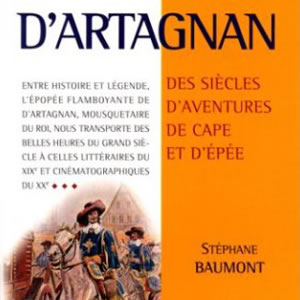 D’Artagnan: Centuries of Sword and Cape Adventures, Privat Editions, collection Pages Grand Sud, 1999.
D’Artagnan: Centuries of Sword and Cape Adventures, Privat Editions, collection Pages Grand Sud, 1999.
Stéphane Baumont is a man of many passions: Gascony, its inhabitants, its historic sites and its rural culture, as well as a passion for teaching. He is a lecturer at the University of Toulouse, where he specializes in constitutional law and political philosophy.
Extract from the cover: This work retraces the history of the most famous of musketeers and analyzes, for the first time, the construction and development of a myth that has crossed centuries to make the twentieth century, thanks to film, the “century of d’Artagnan”.
... and also ...
• 1963
Pierre de Montesquiou
« The Real d’Artagnan »
Editions Julliard
• 1982
Henri Castex
« The d’Artagnans in history » Editions LPF
• 1994
Geneviève Farret
« D’Artagnan »
Conseil Général et CDDP du Gers
• 1998
Sylvie Monin
« The d'Artagnans in Burgundy »
Edited by the Association d’Artagnan
• 2001
Henri Nicolas
« And Charlotte married d’Artagnan… »
Editions de l’Armançon
• 2005
Odile Bordaz
« On the paths of d’Artagnan and the Musketeers »
Editions Balzac
(1) cadet: French word for second, or younger, son. As the eldest son usually inherited from his parents, among the only options for a second-born son to amass wealth and titles was to take up the soldier’s life.
(2) Paris has long been the demographic, economic, cultural and political capital of France. Therefore, “going up to Paris” (monter à Paris) was the phrase used to describe those who left their life in the provinces in search of fame or fortune in Paris.
